Text

In the realm of natural wastewater treatment, constructed wetlands have become a preferred choice for their efficiency and eco-friendliness. While both aerated and passive wetlands offer viable solutions, the focus is increasingly shifting towards aerated wetlands for their exceptional benefits. Despite requiring more land, their adoption continues to rise across various sectors.
0 notes
Text
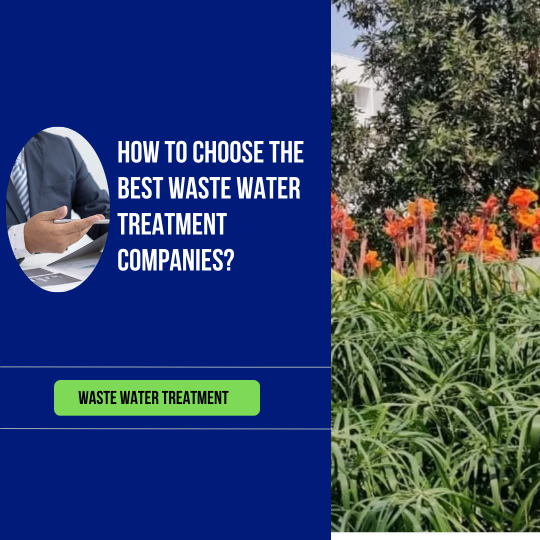
Discover the essential elements for selecting the best wastewater treatment companies in India. Learn how to navigate the complex landscape effectively to find the best.
0 notes
Text
How to choose the best waste water treatment companies
Discover the essential elements for selecting the best wastewater treatment companies in India. Learn how to navigate the complex landscape effectively to find the best.
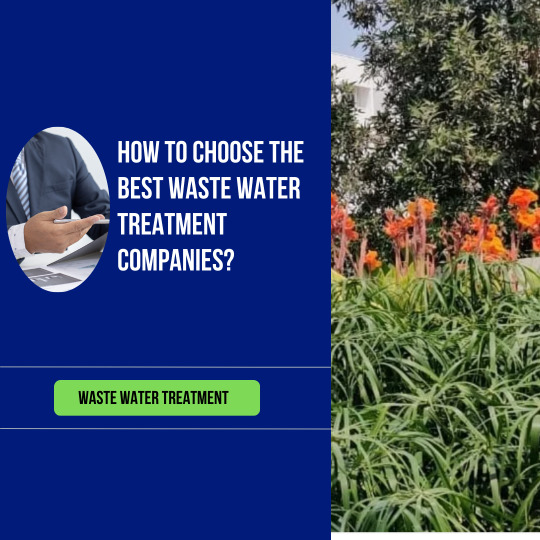
In an era where environmental consciousness gaining supreme importance, the demand for effective wastewater management has reached unprecedented heights. From sprawling industrial complexes to bustling municipalities, the imperative to uphold stringent compliance standards for environmental protection, sustainability, and public health has never been more pronounced.
However, the efficacy of wastewater treatment systems hinges not only on their design but also on the expertise and reliability of the companies entrusted with their implementation. With a wide range of options available, selecting the right wastewater treatment company can seem like navigating a labyrinth of choices.
Fear not, for we've listed the essential elements to guide you in your quest for the best wastewater treatment companies in India.
List out the sources
To navigate the complex landscape of wastewater treatment companies effectively, it's imperative to understand the specific needs of your industry such as residential complex, or commercial establishment. Recognize that not all companies offer solutions tailored to every category, whether it be industrial wastewater treatment, residential water purification, or commercial sewage treatment.
Once you've identified your category, whether it's biological wastewater treatment plants or conventional solutions, compile a list of reputable suppliers specialising in your area of interest. By aligning your needs with the expertise of the chosen suppliers, you can ensure the optimal performance of your wastewater treatment system
Learn about their expertise
When selecting the best wastewater treatment company, prioritise assessing their experience and expertise to ensure a seamless partnership. Evaluate their track record, considering factors such as years of experience, successful project implementations, and their proficiency in dealing with specific pollutants.
Gauge the capacity of the treatment plants they've worked with to determine their capability to meet your needs. Additionally, consider their flexibility in working within varying budget levels to ascertain compatibility. By thoroughly examining these aspects, you can make an informed decision on whether proceeding with the respective wastewater treatment company aligns with your objectives and expectations.
Step by step process followed
To effectively narrow down the options and identify the best wastewater treatment companies, it's crucial to evaluate their approach to designing and implementing treatment plants. Look for companies that prioritise personalised solutions tailored to the unique needs of each client.
A thorough site visit and detailed assessment of requirements, including soil types, water loads, fluctuations, impurities, and discharge methods, demonstrate a commitment to understanding and addressing specific challenges. By opting for companies that prioritise customisation and optimisation, you can ensure the development of sewage treatment plants (STPs) or effluent treatment plants (ETPs) that deliver optimal performance while meeting environmental standards and operational efficiency goals.
Compliance Standards and Maintenance Support
When selecting the optimal wastewater treatment company, adherence to compliance standards and provision of comprehensive support are paramount considerations. Verify that the company prioritises compliance with regulatory requirements and offers assistance in obtaining necessary permissions, as adherence to standards is essential for successful plant implementation.
Additionally, prioritise companies that provide robust maintenance support, ensuring seamless operation of the designed treatment plants. Maintenance support encompasses arranging resources, technical expertise, and timely replacements of machinery or chemicals as needed, thereby facilitating consistent performance and mitigating operational challenges.
By prioritising companies that excel in both compliance and maintenance support, you can ensure the sustained effectiveness and longevity of your sewage or effluent treatment plants.
Conclusion: By understanding your specific needs, assessing companies' expertise, and evaluating their approach to plant design and implementation, you can make informed decisions. Prioritise compliance and maintenance support for sustained effectiveness. Choose wisely to ensure optimal performance and environmental sustainability for your wastewater treatment needs.
0 notes
Text
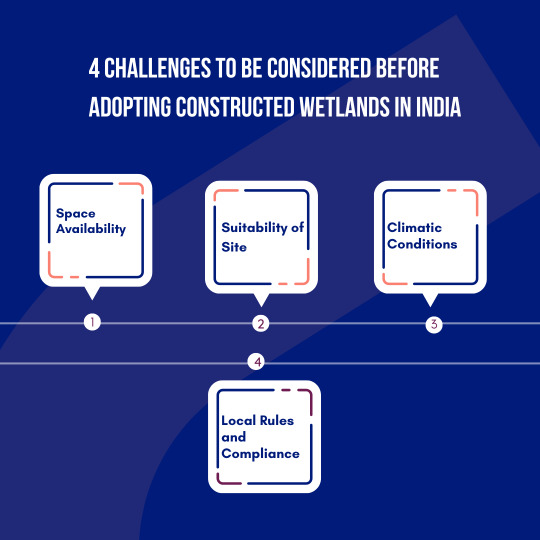
In recent years, constructed wetlands have emerged as a leading solution for wastewater treatment, thanks to their sustainability, eco-friendliness, and effectiveness in handling large volumes of wastewater. However, amidst their rising popularity, it's crucial to recognize and address the specific challenges associated with their adoption, particularly in regions like India.
0 notes
Text
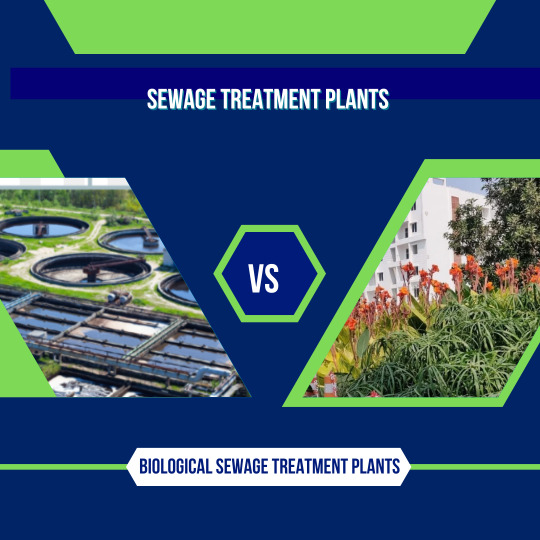
Let's explore the important considerations of Sewage treatment plants (STPs) and biological sewage treatment plants to efficiently manage the increasing volumes of wastewater is imperative in the face of growing global populations.
0 notes
Text
Sewage Treatment Plants Vs Biological Sewage Treatment Plants
Let's explore the important considerations of Sewage treatment plants (STPs) and biological sewage treatment plants to efficiently manage the increasing volumes of wastewater is imperative in the face of growing global populations.
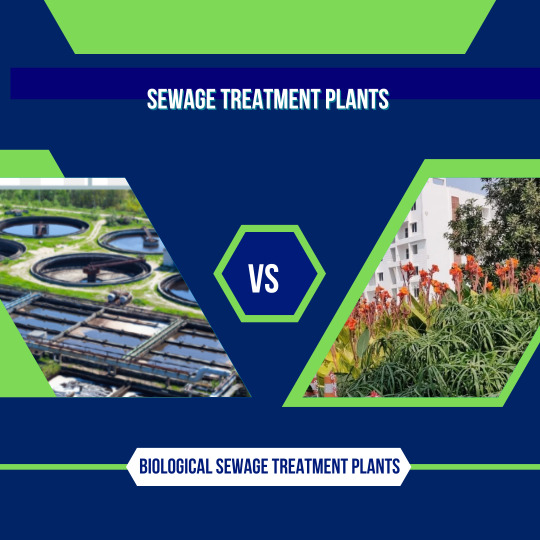
As the global population continues to grow, so does the challenge of managing the increasing volumes of wastewater generated daily. Municipalities and large residential complexes face mounting pressure to adhere to stringent compliance standards to ensure environmental safety and sustainability.
In this scenario, sewage treatment plants emerge as crucial lifelines for wastewater treatment, offering a means to tackle this pressing issue. However, amidst the various sewage treatment methods available, the debate between traditional sewage treatment plants and biological sewage treatment plants takes center stage.
Each approach brings its own set of benefits and considerations, paving the way for a closer examination of their respective merits and effectiveness in addressing the escalating wastewater management challenges of the modern era.
Sewage Treatment Plants
Sewage treatment plants (STPs) serve as vital infrastructure for managing wastewater generated from various human activities, containing a wide range of pollutants, including human excretions. These plants play a crucial role in treating wastewater to ensure it is safe for reuse in different domestic applications or for discharge into natural water resources.
By employing a combination of physical, chemical, and biological processes, STPs aim to remove contaminants and impurities from wastewater, thereby safeguarding public health and the environment.
.
Biological Sewage Treatment Plants
Biological sewage treatment plants, in contrast to traditional sewage treatment plants (STPs), offer a natural and environmentally friendly approach to wastewater purification.
These plant-based systems utilize natural soil and aquatic vegetation, along with a diverse array of microorganisms, to effectively purify wastewater. By harnessing microbial activity, biological sewage treatment plants break down organic matter and extract nutrients and minerals, ultimately achieving compliance with stringent environmental standards.
This eco-conscious method not only minimizes the use of chemicals but also promotes the sustainable management of wastewater, aligning with broader efforts to preserve and protect our natural ecosystems.
Sewage Treatment Plants Vs Biological Sewage Treatment Plants
1.Sewage treatment plants (STPs) are comprehensive systems that involve multiple stages of wastewater treatment, including preliminary, primary, secondary, and tertiary levels. In contrast, biological sewage treatment plants focus primarily on secondary and tertiary purification stages.
2.While traditional STPs address a wider range of contaminants and pollutants, biological STPs streamline the process, focusing on natural methods of purification, primarily through biological and ecological mechanisms, thus reducing the number of treatment stages required.
3.Traditional sewage treatment plants typically require more space for machinery and infrastructure, as well as a controlled environment to ensure optimal performance. In comparison, biological sewage treatment plants may initially require slightly more space for plant construction. However, once operational, these plants operate more naturally and systematically, requiring less space for ongoing maintenance and operation. This natural approach contributes to a more sustainable and eco-friendly wastewater treatment process.
4.Maintaining and operating traditional sewage treatment plants demands highly skilled technical resources due to the complexity of the machinery and processes involved. Conversely, biological sewage treatment plants require fewer technical resources and less specialized expertise for day-to-day maintenance and operation. With minimal training, a smaller team can effectively manage and oversee the operations of a biological sewage treatment plant, reducing overall resource requirements and operational costs.
5.Traditional sewage treatment plants often rely on the use of chemicals to facilitate the purification process, adding to operational expenses and posing environmental concerns. In contrast, biological sewage treatment plants operate without the need for chemicals, relying instead on natural processes and microbial activity to break down organic matter and remove contaminants. This absence of chemical usage not only reduces operational costs but also minimizes environmental impact, making biological sewage treatment plants a more sustainable and eco-friendly option.
6.Traditional sewage treatment plants may experience fluctuations in energy consumption and chemical utilization due to changes in water loads and pollutant components. These fluctuations can lead to increased energy costs and higher operational expenses. In contrast, biological sewage treatment plants operate more consistently and efficiently, with minimal variations in energy consumption and chemical usage. This stability in operation helps to mitigate the risk of unexpected costs and ensures more predictable operational expenses over time.
7.The use of mechanical machinery and chemicals in traditional sewage treatment plants can contribute to odour, noise, and overall unpleasantness in the surrounding environment. In contrast, biological sewage treatment plants operate using natural processes and ecological mechanisms, resulting in minimal odour, noise, and disruption. This allows for a more harmonious coexistence with the surrounding ecosystem and provides an opportunity to enjoy the natural environment while effectively treating wastewater.
The Problem of Active Sludge
One of the significant challenges faced by wastewater treatment suppliers is the management of active sludge, which refers to the raw waste produced and settled down at each stage of the water purification process. This sludge requires treatment to meet safety standards before disposal, posing logistical and environmental concerns. In contrast, one of the notable advantages of biological sewage treatment plants is the absence of sludge accumulation. By harnessing natural processes and microbial activity, these plants effectively break down organic matter and remove contaminants without producing significant sludge. This not only simplifies the treatment process but also reduces the need for extensive sludge management measures, making biological sewage treatment plants a more efficient and environmentally friendly solution for wastewater treatment.
In conclusion, the debate between sewage treatment plants and biological sewage treatment plants underscores the importance of exploring innovative and sustainable solutions to the global wastewater management challenge.
While traditional sewage treatment plants offer comprehensive purification methods, biological sewage treatment plants present a natural and environmentally friendly alternative. Each approach has its unique benefits and considerations, ranging from treatment efficiency and space requirements to operational complexity and environmental impact.
By carefully weighing these factors and considering the specific needs of each wastewater management scenario, stakeholders can make informed decisions to ensure effective and sustainable wastewater treatment practices
0 notes
Text
0 notes
Text
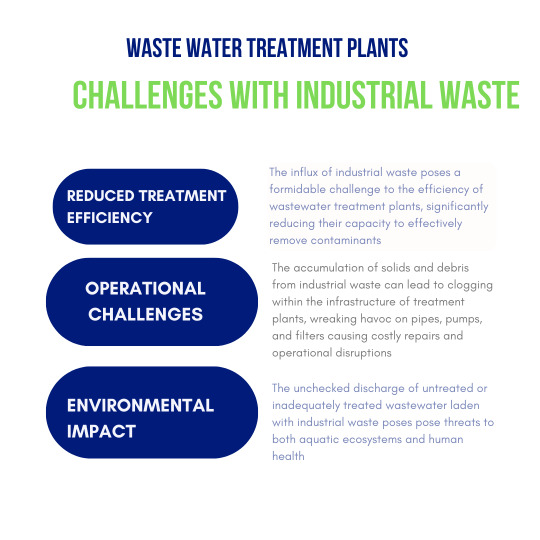
Industrial wastewater is a complex mix of chemicals, minerals, and contaminants that conventional treatment methods struggle to handle. The sheer diversity and concentration of pollutants overwhelm treatment processes, reducing their efficiency and effectiveness.
0 notes
Text
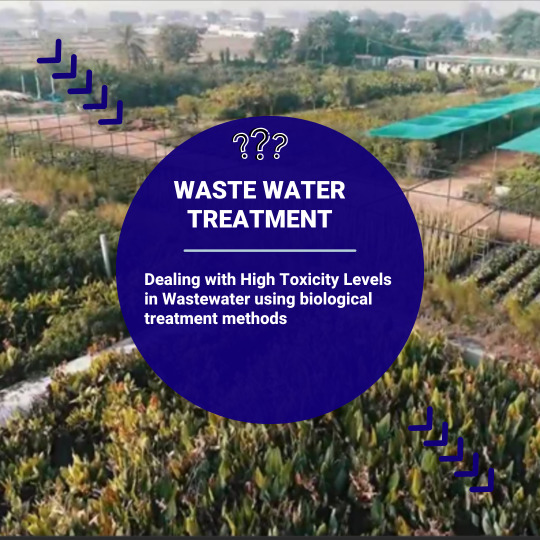
Despite doubts surrounding the efficiency of biological effluent treatment plants, delve into five transformative methods of biological solutions to fight high toxicity levels in industrial wastewater
0 notes
Text
Dealing with High Toxicity Levels in Wastewater: Exploring solutions for treating using biological treatment methods and mitigating their harmful effects.
Despite doubts surrounding the efficiency of biological effluent treatment plants, delve into five transformative methods of biological solutions to fight high toxicity levels in industrial wastewater
Despite the commendable mark made by biological effluent treatment plants as eco-friendly solutions for industrial wastewater, suspicion looms over their capacity to effectively fight high toxic pollutants.
This concern becomes particularly pronounced in industries dealing with diverse byproducts, such as textiles, which rank among the top contributors to water pollution. Textile industries, reputed for their extensive use of chemicals, dyes, and bacteria, pose a unique challenge in wastewater management.
In this context, delving into five powerful biological solutions tailored to handle the formidable task of mitigating extremely high toxic pollutants prevalent in industrial wastewater becomes imperative.
Let's navigate the landscape of these solutions and explore their potential to revolutionize the treatment of industrial effluents
Bioremediation Techniques:
One of the most crucial way to deal with high toxicity levels in the world of modern wastewater treatment is the implementation of bioremediation techniques.
This process employs microorganisms, including bacteria, fungi, or algae, to effectively break down and metabolize toxic compounds, transforming them into less harmful substances. The beauty of bioremediation lies in its adaptability, biological agents can be either specifically selected or engineered to target particular pollutants, providing a sustainable and environmentally friendly solution.
By harnessing the power of nature's microorganisms, this method not only addresses the immediate concern of toxic wastewater but also aligns with the principles of eco-friendly and efficient wastewater treatment.
Constructed Wetlands:
In addressing the challenge of high toxicity levels in wastewater, the utilization of constructed wetlands emerges as a powerful and effective biological treatment method.
These engineered artificial wetland systems capitalize on natural processes, including microbial activity, plant uptake, and sedimentation, to systematically remove contaminants from wastewater. The carefully curated ecosystem within these constructed wetlands, featuring selected natural soils and aquatic plants, plays a pivotal role in breaking down toxic substances and enhancing water quality.
Phytoremediation:
Phytoremediation emerges as a noteworthy biological treatment method for combating high toxicity levels in wastewater. This technique harnesses the unique capabilities of plants to absorb, accumulate, and detoxify pollutants from the water.
Specifically selected plant species after evaluation of toxic substances present in waste water, known for their ability to tolerate and accumulate high levels of toxic substances, play a crucial role in this remediation process.
Once these plants have fulfilled their detoxification duty, they are harvested and appropriately disposed of, ensuring the effective removal of contaminants from the environment. Phytoremediation, with its reliance on the natural power of plants, stands as a sustainable and environmentally friendly solution in the quest to mitigate the harmful effects of toxic pollutants in wastewater.
Bioaugmentation:
In the realm of wastewater treatment, bioaugmentation emerges as another powerful strategy to handle high toxicity levels. This method involves the introduction of specialized microorganisms into the wastewater treatment system, aiming to enhance its capacity to degrade toxic compounds.
The added microorganisms act as reinforcements, suppressing the existing microbial community with specific enzymes that contribute to a more efficient breakdown and elimination of toxic pollutants which makes bioaugmentation stands as a very targeted and effective biological treatment method to eliminate the high toxic levels present in waste water
Monitoring and Adaptive Management:
In the world of wastewater treatment among high toxicity challenges, continuous monitoring becomes crucial for success. Employing biological treatment methods necessitates a vigilant approach to toxicity levels and the efficacy of chosen strategies.
Adopting an adaptive management framework allows for real-time adjustments based on accurate data, ensuring the treatment process remains optimized. Regular assessments not only contribute to the ongoing refinement of the chosen biological methods but also facilitate the swift identification of emerging challenges. This dynamic and proactive approach not only enhances the overall effectiveness of wastewater treatment but also ensures a sustainable, long-term solution to combat the harmful effects of high toxicity levels in water resources.
Conclusion:
In the realm of wastewater treatment, addressing high toxicity levels requires a multifaceted approach grounded in powerful biological solutions. These approaches collectively stand as a testament to the potential of biological treatment methods in reshaping the landscape of industrial effluent treatment and ensuring sustainable, eco-friendly practices in wastewater management.
0 notes
Text
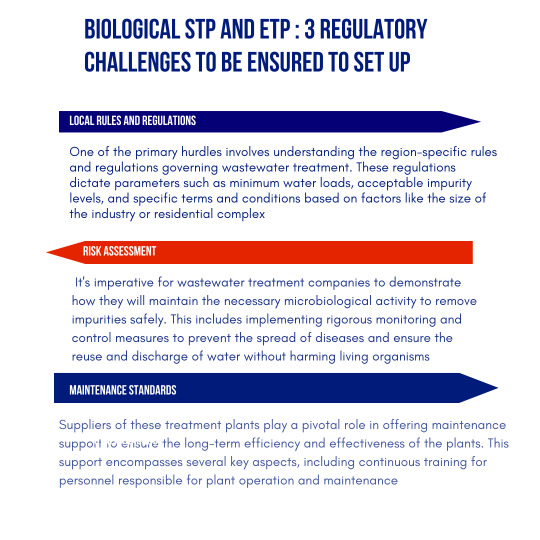
As the global community grapples with mounting wastewater management issues, the spotlight is increasingly shifting towards biological Sewage Treatment Plants (STPs) and Effluent Treatment Plants (ETPs).
0 notes
Text

Explore how Biological Waste Water Treatment Plants in India stands as the best choice, ensuring a clean, serene environment while prioritizing the health of soil and vegetation for long-term sustainability.
0 notes
Text
Why biological Waste Water Treatment Plants Stands as The Best in India
Explore how Biological Waste Water Treatment Plants in India stands as the best choice, ensuring a clean, serene environment while prioritizing the health of soil and vegetation for long-term sustainability.
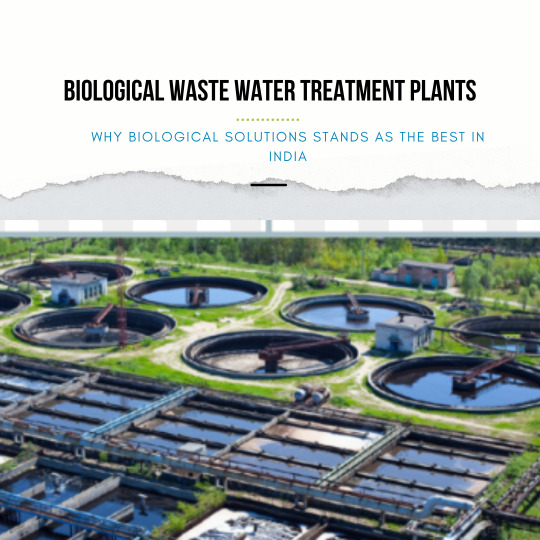
In India's pursuit of sustainable wastewater management, Biological Sewage Treatment Plants (STPs) and Effluent Treatment Plants (ETPs) emerge as transformative solutions.
This blog delves into the distinctive merits of biological Waste Water Treatment systems, unraveling the reasons why they stand as the cornerstone of efficiency and environmental consciousness in the realm of wastewater treatment.
Minimal Infrastructure Requirements
In the realm of wastewater treatment, biological Sewage Treatment Plants (STPs) and Effluent Treatment Plants (ETPs) emerge as stellar solutions in India. These innovative systems operate seamlessly, avoiding the need for elaborate infrastructure.
Leveraging the power of natural wetlands, enriched with native soil and vegetation, these biological treatment plants not only streamline operations but also epitomize eco-friendly practices. The inherent simplicity in design and reliance on nature's own filtration processes make biological STPs/ETPs an environmentally conscious choice.
India's embrace of these biological wastewater treatment methods signals a commitment to sustainable and efficient solutions, aligning with the nation's growing emphasis on ecologically sound practices for wastewater management.
Chemical-Free Water Purification
Biological Waste Water Treatment Plants emerge as the preferred choice for a multitude of reasons. A key highlight is the absence of artificial chemicals in the purification process, presenting a substantial advantage. This not only eliminates the ongoing costs associated with chemical purchases and refills but also champions a healthier approach to water purification.
The reliance on natural biological processes not only proves cost-effective but also aligns with the signs of environmental sustainability, reducing the ecological footprint of wastewater treatment practices in the country.
As India places increasing emphasis on eco-conscious solutions, the adoption of biological wastewater treatment plants stands out as a environmentally friendly choice, paving the way for a greener and more sustainable water management landscape.
Low Technical Staff Requirement
Biological Waste Water Treatment Plants shine as the optimal choice in India's wastewater treatment landscape, offering a distinct advantage over traditional counterparts. Their operational efficiency is highlighted by the minimal technical expertise needed for maintenance and operation, a stark departure from the complexities associated with conventional systems.
With just 1–2 trained resources, these biological plants can effectively operate within regulatory standards, streamlining staffing requirements. This simplicity not only minimizes operational costs but also ensures that even in regions with limited technical resources, these plants can be successfully implemented.
In a nation where accessibility and ease of operation are paramount, biological wastewater treatment plants emerge as a emergic solution
Absence of Odour, Sludge, and Noise
The ascendancy of Biological Sewage Treatment Plants (STPs) and Effluent Treatment Plants (ETPs) in India's wastewater treatment area is underscored by their remarkable capacity to eliminate common challenges associated with traditional methods.
These biological systems eradicate unpleasant odors, prevent sludge accumulation, and spare the environment from the disruptive noise generated by large machinery. In their place, a clean, peaceful atmosphere prevails, enhancing the overall visual appeal of the surroundings.
This transformative shift not only addresses the practical challenges of wastewater treatment but also contributes to a more aesthetically pleasing and harmonious environment, aligning with India's pursuit of sustainable and community-friendly solutions in the realm of water management.
Sustainability Through Soil and Vegetation Health
The supremacy of biological wastewater treatment plants in India derives from their inherent commitment to sustainability, intricately intertwined with the well-being of soil and vegetation.
Unlike conventional methods, these systems prioritize the health of these natural elements, fostering a symbiotic relationship that ensures not only the immediate effectiveness of the treatment process but also long-term environmental harmony. This approach aligns seamlessly with India's evolving environmental consciousness, emphasizing the interconnectedness of water treatment practices with the broader ecosystem.
As these biological systems champion the health of the soil and vegetation, they stand as guardians of not just water purity but also as stewards of the land, embodying a holistic and sustainable approach to wastewater management in the country.
Conclusion:
In a nation embracing sustainable practices, the adoption of Biological Waste Water Treatment Plants in India signifies a monumental stride towards efficient, eco-friendly wastewater management. From minimizing infrastructure demands to championing chemical-free purification and requiring minimal technical staff, these systems not only address current challenges but also contribute to a harmonious environment. As balance of both water purity and the land, these biological systems underscore a holistic and enduring approach to wastewater treatment in the country.
0 notes
Text
0 notes